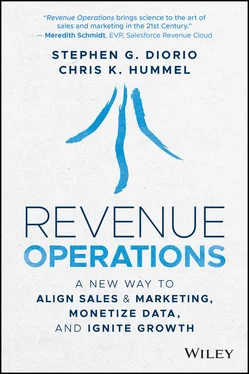Stephen Diorio - Revenue Operations
Здесь есть возможность читать онлайн «Stephen Diorio - Revenue Operations» — ознакомительный отрывок электронной книги совершенно бесплатно, а после прочтения отрывка купить полную версию. В некоторых случаях можно слушать аудио, скачать через торрент в формате fb2 и присутствует краткое содержание. Жанр: unrecognised, на английском языке. Описание произведения, (предисловие) а так же отзывы посетителей доступны на портале библиотеки ЛибКат.
- Название:Revenue Operations
- Автор:
- Жанр:
- Год:неизвестен
- ISBN:нет данных
- Рейтинг книги:3 / 5. Голосов: 1
-
Избранное:Добавить в избранное
- Отзывы:
-
Ваша оценка:
- 60
- 1
- 2
- 3
- 4
- 5
Revenue Operations: краткое содержание, описание и аннотация
Предлагаем к чтению аннотацию, описание, краткое содержание или предисловие (зависит от того, что написал сам автор книги «Revenue Operations»). Если вы не нашли необходимую информацию о книге — напишите в комментариях, мы постараемся отыскать её.
Revenue Operations: A New Way to Align Sales and Marketing, Monetize Data, and Ignite Growth
Revenue Operations
Revenue Operations
Revenue Operations — читать онлайн ознакомительный отрывок
Ниже представлен текст книги, разбитый по страницам. Система сохранения места последней прочитанной страницы, позволяет с удобством читать онлайн бесплатно книгу «Revenue Operations», без необходимости каждый раз заново искать на чём Вы остановились. Поставьте закладку, и сможете в любой момент перейти на страницу, на которой закончили чтение.
Интервал:
Закладка:
Unfortunately, many people still perceive growth as a form of “art” and fail to understand the science of growth. These people often see business functions through a very narrow lens: marketing is a creative discipline with little or no connection to financial outcomes; selling is about personal relationships, not method; and superstar sellers are treated as kings and queens – despite being hard to manage and even harder to replicate.
Also, executives cannot agree on the causal chain of events that leads to revenue growth and future cash flow, the keys that underlie firm value. This leaves executives without a financially valid way to make growth bets, weigh trade-offs, and optimally allocate resources across growth alternatives. It also makes it difficult to build a business case and management consensus on the capabilities that can create the greatest value to the firm. For example, most business leaders pay lip service to the notion of being data driven, digital, agile, and customer focused as a basis for competitive advantage. They understand these things are strategically important, but in most cases, they don't have a basis for evaluating these strategic value drivers and lack a tangible set of corporate initiatives to exploit them in the marketplace. Academic research proves, however, that these are the primary causal factors that determine the financial value of the enterprise.
Corporate executives struggle with the long-term growth formula. They can rarely agree on the big questions underlying their growth strategy such as the measurement, value, and importance of growth assets. “With all the focus on advanced analytics and data-driven marketing, not much progress has been made on understanding the fundamental math of growth in a business,” reports Professor Dominique Hanssens of the UCLA Anderson School of Management and author of the book The Long Term Impact of Marketing . “In my experience, executive teams that make the big growth bets often lack consensus and alignment on fundamentals like the true cost of customer acquisition, the right balance of customer acquisition relative to customer retention, and the financial contribution of the brand to the business.” 104
Real-World Problems Cross Organizational Boundaries
Growing a business is an interdisciplinary endeavor. A team sport. Any “go-to-market” strategy has dozens of functions to manage and many more disciplines to master. These functions include traditional growth disciplines like marketing, sales, and customer service. They also include brand management, product development, and the “4Ps” of pricing, promotion, product packaging, and placement. New disciplines like sales enablement, customer analytics, earned media management, and content management have emerged as these budgets have grown to command 15% or more of business-to-business (B2B) growth budgets.
There are job descriptions for all of these individual disciplines. There are millions of experienced managers and experts in these functional disciplines. Universities offer master's degrees and PhDs in most of these disciplines. Individually.
Organic growth requires all these disciplines to work together in unison toward a common end – consistent, profitable, and scalable growth. There is no curriculum for that. Few CEOs have direct experience in these disciplines. Less than 20% of CEOs have direct experience in sales. Few marketers become CEOs.
This is the underlying reason why few managers have been able to master the science of growth. “The root cause of this problem is that historically academic and business institutions have taught and managed the science of growth as a set of individual disciplines – branding, product management, marketing and analytics,” says Professor David Reibstein of the Wharton School of Business. “But the real-world problem of growing a business is interdisciplinary in nature. We as teachers need to do a better job of creating skills, structures, and leaders who can manage, coordinate, and align all these disciplines coherently around the customer. Being the captain that coordinates and leads all those functions in a business is a very big job. But an essential one.”
Academic and commercial research overwhelmingly supports the concepts that growth is a “team sport” and that there is a causal relationship between organizational competence in analytics, marketing, information sharing, agility, and cross-functional collaboration with enterprise value. This researchshows that a 10% increase in organizational competence will drive on average a 5.5% increase in stock price. 7An analysis of 380 CMOs by Forbes found that organizations investing in data-driven measurement processes, competencies and systems were achieving significantly higher levels of marketing effectiveness and business outcomes – achieving 5% better returns on marketing investments and more than 7% higher levels of growth performance. 105The analysis revealed that these high-performing marketers – who were exceeding growth goals by over 25% – were significantly more data-driven in their approach to measuring, optimizing, and reallocating their offline and online sales and marketing investments.
The Role of Insight in Value Creation
Investments in customer insights and organizational agility do create firm value. How fast and effectively an organization analyzes, leverages, and shares information and customer data can increase tactical marketing returns but also generate long-term enterprise value. 63Academic research has proven there is a significant relationship between how fast your organization shares data and customer insights across revenue teams and share price. 8A comprehensive analysis of 114 academic research studies by the Marketing Science Institute (MSI)has demonstrated that the ability of an organization to generate, disseminate, and respond to market intelligence – called Organizational Knowledge Sharing – has a quantifiable positive effect on firm value and financial performance in terms of profits, sales, and market share. 6
Managers need to recognize and prioritize the importance of sharing knowledge across the business. Modern selling systems produce customer data that allows revenue teams to identify trigger events that signal buying intent, flag inquiries from important influencers within accounts, and make decisions about next best actions based on past customer behavior. The window of time an organization has to act on that data is small, however – and is gated by customer time, attention, and expectations for response. This makes hastening data and decisions about an opportunity from the source (e.g. a website, an algorithm in marketing) to a customer-facing employee who can act on it (e.g. a relationship manager or customer service rep) a critical value driver.
Similarly, customer relationships, go-to-market effectiveness, organizational information sharing, customer experience, and the quality of products, people, and innovations have all been empirically proven to drive increases in firm value by academics. 6
In particular, the push to focus the organization on customer lifetime value as the primary objective of the revenue team has a financial basis. Customer equity is a significant driver of share price. According to academic research, the value elasticity of customer equity is 0.72. 8This means a 10% increase in the value of customer assets will drive a 7.2% increase in stock price because higher levels of customer satisfaction, trust, and online service innovations enhance long-term margins, sales growth, and enterprise value. Hence, lifetime value is being redefined as an economic model in a digitally driven economy. This is evidenced by the ability of businesses like Airbnb ($125B in firm value with no profits at the time of printing) and the GHX Global Healthcare Exchangeto convert digitally enabled consumer and business networks into valuable assets. 108 , 60
Читать дальшеИнтервал:
Закладка:
Похожие книги на «Revenue Operations»
Представляем Вашему вниманию похожие книги на «Revenue Operations» списком для выбора. Мы отобрали схожую по названию и смыслу литературу в надежде предоставить читателям больше вариантов отыскать новые, интересные, ещё непрочитанные произведения.
Обсуждение, отзывы о книге «Revenue Operations» и просто собственные мнения читателей. Оставьте ваши комментарии, напишите, что Вы думаете о произведении, его смысле или главных героях. Укажите что конкретно понравилось, а что нет, и почему Вы так считаете.











